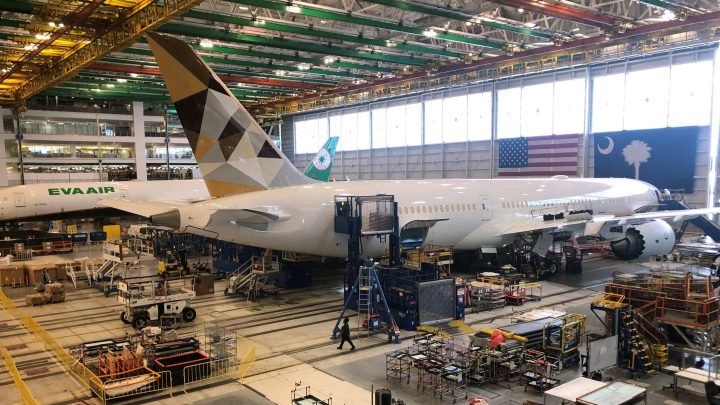
Aircraft orders can distort economic data. They also propel a lot of economic activity.
Aircraft orders can distort economic data. They also propel a lot of economic activity.

Orders of vehicles, computers, equipment and other durable goods rose 0.2% in August from July, according to the Commerce Department. That’s after falling 5.6% in July. The August increase was driven in large part to machinery orders, which have increased in four of the last five months.
The Commerce Department also said orders rose at a faster rate if you exclude transportation orders. Those can be volatile month-to-month — so volatile that economists often ignore them since big swings in the data don’t reveal much about the underlying economy.
There’s a reason aircraft orders in particular tend to swing around so much: Aircraft are incredibly expensive compared to other transportation equipment. Samuel Engel, with the consulting company ICF, said if an airline wants to order one Boeing 737 Max 8, it faces a list price of roughly $120 million.
“It’s something that takes place after not just very careful consideration, but also after intense negotiation,” Engel said.
Engel said airlines can negotiate those prices down by ordering big batches of aircraft at once.
“The airline IndiGo in India ordered 500 aircraft in 2023,” Engel said. “United, last year, ordered 200 aircraft from Boeing. So, these are really large orders.”
And large orders only happen once in a while. Engel said airlines tend to cluster their orders around big industry events, like the Paris Air Show in June.
“That doesn’t mean that when there are no orders announced in July that demand has fallen off,” Engel said.
But while aircraft orders jump around, there’s a steady pipeline of aircraft being made all the time to fulfill those orders. In fact, manufacturers tend to have big backlogs, said Kevin Michaels, managing director of AeroDynamic Advisory.
“If you’re ordering an A320 from Airbus, you could be waiting eight years until you get delivery, if you get in line today,” Michaels said.
Michaels said one aircraft order is really thousands of orders for all the parts and materials that go into an aircraft.
“For certain materials, it can take over a year to get delivery,” Michaels said. “And that’s before you start cutting metal and creating a part.”
Every one of those parts is created by a manufacturer with its own supply chain. The airplane industry breaks this up into a hierarchy, with manufacturers that supply the aircraft makers themselves at the top.
“We would be a Tier 1 supplier,” said Colin Mahoney, president of customer and account management at Collins Aerospace, which makes everything from engine control systems and landing gear to the things you see when you enter a plane. “Look to the left, you see the flight deck, all those fancy displays and two seats, where the pilots sit. We do all of that. Look ahead, you’ve got the galleys, the fridges, the ovens, the coffee makers. We do all of that.”
Mahoney said his company makes a lot of those parts in-house. It also works with a long list of suppliers. “You could say it’s in the thousands. It’s a nontrivial amount.”
Every time a Tier 1 supplier needs a part, a Tier 2 supplier gets to work.
One of those suppliers is San Diego Aircraft Interiors in Chula Vista, California, which manufactures seat covers. Joe Medeiros, SDAI’s supply chain director, said the company sells covers to seat manufacturers and to the airlines themselves.
Medeiros said his seat covers are typically the last thing installed on an airplane. But his company isn’t at the end of the aircraft supply chain — it has suppliers of its own.
“We buy from manufacturers of Ultraleather,” Medeiros said. “There’s a few in the world that do the high-quality leather like that. There’s thread. There’s foam.”
Medeiros said from the moment an airline orders an aircraft, it might be three years before his business gets an order for seat covers. And in that time, one order can generate revenue for businesses all along the aircraft supply chain.
“It supports our 50 employees here, as well as their families, but it also supports our local suppliers, it helps brings revenue to the city,” Medeiros said.
In other words, the number of aircraft orders this month can be an indicator of how business may look years from now.
Correction (Sept. 28, 2023): A previous version of this story misstated the type of engine equipment Collins Aerospace manufactures.
There’s a lot happening in the world. Through it all, Marketplace is here for you.
You rely on Marketplace to break down the world’s events and tell you how it affects you in a fact-based, approachable way. We rely on your financial support to keep making that possible.
Your donation today powers the independent journalism that you rely on. For just $5/month, you can help sustain Marketplace so we can keep reporting on the things that matter to you.











